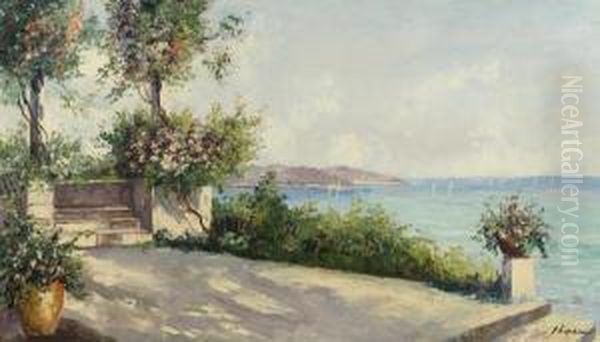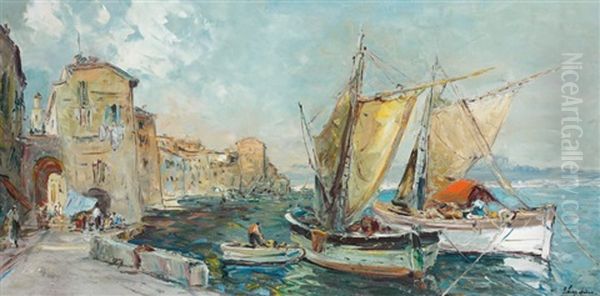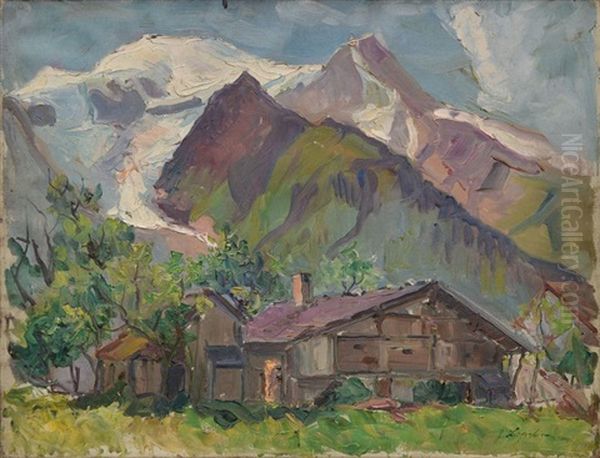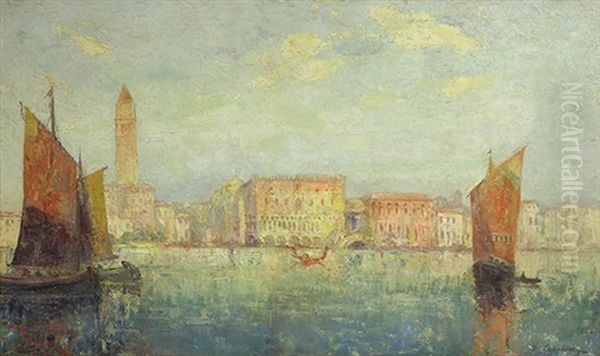Georgi Alexandrovich Lapchin, also known by the French transliteration Gueorgui Alexandrovitch Lapchine, stands as a notable figure in early 20th-century Russian art. Born in Russia in 1885, his life spanned a tumultuous period of history, concluding in 1950. Lapchin primarily dedicated his artistic endeavors to painting, leaving behind a body of work appreciated for its technique and sensitivity to environment.
While details of his earliest training remain somewhat scarce in readily available records, his career clearly blossomed, leading him eventually to France, a common path for many Russian artists seeking broader artistic currents and exhibition opportunities during that era. His presence in the West is confirmed by his participation in significant Parisian Salons.
Artistic Style and Influences
Lapchin's artistic identity is often linked with Neo-Impressionism, a movement pioneered by French artists like Georges Seurat and Paul Signac. This style is characterized by its scientific approach to color and light, often employing techniques like pointillism, where small, distinct dots of color are applied in patterns to form an image. While the provided information labels him Neo-Impressionist, other descriptions lean towards Realism or Neo-Realism, suggesting a style that perhaps evolved or selectively incorporated different techniques.
His works consistently demonstrate a strong command of the oil painting medium. He applied paint with confidence, capturing the interplay of light and shadow, whether depicting sun-drenched Mediterranean terraces or the muted light of a Russian winter. The use of "vivid colors" is noted as a characteristic of his Neo-Realist approach, indicating an emphasis on chromatic intensity to convey mood and atmosphere, a trait shared with many Post-Impressionist painters like Paul Gauguin or Vincent van Gogh, though Lapchin's style maintained a more representational footing.

Lapchin’s approach seems rooted in careful observation of the natural world, aligning him with the broader tradition of European landscape painting. His Russian heritage likely brought an influence from masters of Russian landscape like Isaac Levitan or Ivan Shishkin, known for their evocative depictions of their homeland. However, his time in France and travels clearly exposed him to Impressionism and its successors, influencing his palette and brushwork, perhaps echoing the atmospheric concerns of Claude Monet or Camille Pissarro.
Themes and Subjects
Lapchin's oeuvre encompasses a range of subjects, with landscape painting being particularly prominent. He rendered diverse environments, from the coastal scenes of the French Riviera to the canals of Venice and the distinct atmosphere of Russian winters. His works often capture specific locations and moments in time, imbued with a sense of place.
Coastal and waterside scenes appear frequently. Works like Terrasse sur Cap-Martin and Barque de pêche (Fishing Boat) situate the viewer in the Mediterranean light of Southern France. Cap Martin, near Monaco, was a popular subject for artists drawn to its dramatic coastline and lush vegetation. Similarly, Martigues, near Marseille, often called the "Venice of Provence," provided rich subject matter with its canals and fishing boats, as seen in Workers in Martigues.
Venetian scenes, such as Canal View, demonstrate his engagement with iconic European cityscapes. Venice, with its unique interplay of water, architecture, and light, has captivated artists for centuries, from Canaletto to J.M.W. Turner and later Impressionists. Lapchin added his perspective to this tradition, likely focusing on the atmospheric effects and reflections characteristic of the city.
Winter landscapes form another significant part of his work. Paintings like Début de l'hiver (Beginning of Winter) and general references to Winter Landscape and Snowy Forest suggest a deep connection to the Russian seasonal cycle. These works likely explored the specific textures of snow, the stark silhouettes of trees, and the unique quality of light during winter, themes central to Russian landscape painting tradition, exemplified by artists like Konstantin Korovin who also embraced Impressionistic techniques.
Still life subjects, such as Chalet de Montagne (Mountain Chalet), which might be interpreted more as a landscape with architectural focus or potentially include still life elements within that setting, show his versatility. The consistent use of oil paint across these varied themes underscores his commitment to this traditional medium. His signature, often "G. Lapchin," frequently accompanied by a date, grounds his works firmly in his documented period of activity.
Notable Works

Several specific works highlight Lapchin's artistic output and reception. Début de l'hiver, dated 1922, is a significant example. This oil on canvas, measuring approximately 74.6 x 100 cm, captures the onset of winter. Its importance is underscored by the attention it received from the critic V.A. Petrov and its high valuation at auction, estimated between $500,000 and $600,000, indicating considerable market recognition for his work.
Terrasse sur Cap-Martin exists with dating variations, sometimes cited as circa 1923 or 1929. This oil painting depicts a terrace overlooking the sea at Cap Martin, a subject favored for its picturesque views. The work showcases his ability to render light and atmosphere in a sunnier climate, contrasting with his Russian winter scenes. Its dimensions are noted as substantial in some records.
Barque de pêche, dated 1929, is another example of his coastal themes. This oil painting, measuring 59 x 49 cm, likely depicts fishing boats, possibly in Martigues or another Mediterranean location. It reflects his interest in maritime life and the coastal environment.
Chalet de Montagne, also dated 1929, presents a different setting. This smaller oil painting (16 x 22 cm) suggests an interest in alpine or rural architecture within a landscape context. Its modest size might indicate a study or a more intimate work.
Works dated later in his career, such as Canal View (22 x 16.4 cm) and Workers in Martigues (a larger canvas at 50 x 100 cm), both cited as completed in 1950, the year of his death, show his continued activity. Workers in Martigues is particularly interesting as it points towards an engagement with social realism or scenes of daily life, depicting laborers in the Provençal town. This thematic choice aligns him with artists who documented working life, such as Gustave Courbet or Jean-François Millet, albeit within Lapchin's own stylistic framework.
Exhibitions and Recognition
Georgi Lapchin gained recognition through participation in prominent art exhibitions, particularly in Paris, the epicenter of the art world during much of his active period. He exhibited his works at the Salon des Indépendants (Salon of Independents) over a significant span, from 1925 to 1940. This Salon, founded in 1884 by artists including Georges Seurat and Paul Signac, was known for its unjuried format, allowing a diverse range of styles to be shown.

His involvement with the Parisian art scene deepened over time. In 1929, Lapchin joined the Société des Artistes Indépendants, the organization running the Salon. Further integration into the French art establishment came in 1931 when he became a member of the Société des Artistes Français, a more traditional institution known for hosting the annual Paris Salon. Membership in these societies provided visibility and validation within the competitive art world.
The mention of his work being featured in "legendary exhibitions of the left wing of Russian art" suggests a possible connection, perhaps earlier in his career or through specific works, to the Russian avant-garde movements that flourished before and shortly after the Revolution. Artists like Kazimir Malevich or Wassily Kandinsky were central figures in these movements, though Lapchin's known style appears more aligned with Impressionistic and Realistic traditions than radical abstraction. This reference might point to exhibitions held outside Russia featuring émigré artists or works from that period.
The critical attention from figures like V.A. Petrov further solidifies his standing. Art criticism plays a crucial role in shaping an artist's reputation, and having works reviewed indicates a level of contemporary relevance and engagement with the art discourse of the time.
Contemporaries and Context
Lapchin worked during a period of immense artistic ferment. While the provided sources do not document specific collaborations or direct teacher-student relationships with other famous painters, his life and career unfolded alongside numerous major figures in Russian and European art. His presence in Paris placed him geographically near the heart of modern art's development.
In Russia, his formative years overlapped with the Silver Age of Russian Art, seeing the flourishing of Symbolism, the World of Art movement (Mir Iskusstva) with figures like Léon Bakst and Alexandre Benois, and the rise of the avant-garde. While his style seems distinct, he would have been aware of these currents.
His engagement with Neo-Impressionism connects him to the legacy of Seurat and Signac. His landscape work, particularly the French scenes, can be seen in dialogue with the Impressionists like Monet, Pissarro, and Alfred Sisley, and Post-Impressionists such as Paul Cézanne, who also extensively painted the South of France.

As a Russian émigré artist in Paris, he was part of a significant community that included figures like Marc Chagall, Chaïm Soutine, and Constantin Korovin (who also spent time in Paris). These artists navigated the challenges of adapting to a new environment while often retaining elements of their Russian heritage in their work. Lapchin's focus on both Russian and French landscapes reflects this dual context.
His adherence to more representational styles, even while incorporating Impressionistic light and color, set him apart from the more radical abstractionists but aligned him with a strong continuing tradition of Realist and Impressionist-influenced painting practiced by many artists in France and across Europe, including figures like Pierre Bonnard or Édouard Vuillard, known for their intimate scenes and sophisticated color harmonies.
Legacy and Market Presence
Georgi Alexandrovich Lapchin is remembered as a significant Russian painter of the first half of the 20th century, particularly noted for his landscape and cityscape paintings. His work bridges Russian artistic sensibilities with Western European, particularly French, stylistic influences like Neo-Impressionism and Realism.
His paintings continue to be appreciated in the art market, as evidenced by the auction records cited. The substantial estimate for Début de l'hiver and the consistent appearance of other works like Barque de pêche and Chalet de Montagne at auction demonstrate ongoing collector interest. This market presence helps maintain his visibility and contributes to the assessment of his historical importance.
While perhaps not as globally renowned as the leading figures of the Russian avant-garde or the most famous Impressionists, Lapchin holds a secure place within the history of Russian art and the narrative of Russian artists working abroad. His contribution lies in his skillful rendering of light and atmosphere across diverse geographical settings, from the snows of Russia to the shores of the Mediterranean, executed with a technique informed by modern European painting developments yet retaining a distinct representational clarity. His work offers valuable insights into the cross-cultural artistic exchanges of his time.
His life (1885-1950) places him firmly within a generation that witnessed profound historical changes and artistic revolutions. Through his dedicated practice of painting, Georgi Lapchin captured moments of beauty and tranquility in a world often marked by upheaval, leaving a legacy of evocative landscapes that continue to resonate with viewers today.